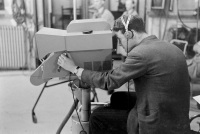 Today we start the three year research project Screen Plays: Theatre Plays on British Television. Research associate Dr Amanda Wrigley and I are setting out to document and explore all the plays written for the theatre that have been produced on British television since John Logie Baird mounted Pirandello’s The Man with a Flower in his Mouth as an experimental production in 1930.
Today we start the three year research project Screen Plays: Theatre Plays on British Television. Research associate Dr Amanda Wrigley and I are setting out to document and explore all the plays written for the theatre that have been produced on British television since John Logie Baird mounted Pirandello’s The Man with a Flower in his Mouth as an experimental production in 1930.
The aims of the project are to document and explore this central component of programming through a freely accessible database of information about productions, together with screenings, conferences and a book. The project will introduce formal and historical analysis to the discussion of theatre plays on television, as well as a focus on the screen language of television plays. To the extent that theatre on television has been previously studied, it has been explored largely within a framework concentrating on drama texts and performance — and we hope to extend the analysis in a variety of ways. The results of the project will be shared and discussed throughout the research period on this blog.
We very much hope that we will be able to develop here a community of enthusiasts, practitioners and academics who are interested in discussing these questions with us and with each other. To give you a sense of some of the questions we’ll be exploring (although our ideas have already moved on, in particular in relation to audiences), here is an extract from the March 2010 application for funding:
The project seeks to understand the institutional, production and technological contexts for these adaptations within both broadcasting and British theatre. The project will develop a historical poetics (the term is David Bordwell’s) studying the principles of television production as they inform the forms and screen languages of television theatre plays in particular historical circumstances. This involves drawing together critical analysis with cultural and institutional histories in broadcasting, theatre and in the funding structures of the arts; media, film and theatre studies; intellectual history and performance studies; and the histories of production technologies and craft practices.
Among the questions to be explored in this critical history are the following. How and why were plays presented on British television? What purposes did the productions serve for the broadcasters and what did they represent in institutional and cultural terms? What production processes were employed, most often in television studios also on occasions with location shooting? How did developing technologies and craft practices impact on the presentation of these plays? What were the experiences of actors, technicians, producers and executives in their creation? What commercial and cultural value did theatre plays have for television, and how on occasions did the theatre benefit or suffer from the presentation of plays?
The project aims to understand the ways in which production practices (including schedules and budgets), technology and institutional frameworks engaged with practices from theatre, variety, radio and cinema to shape what could be regarded as the ‘normative’ style of studio drama – and to chart how this style was sustained and how it evolved from the 1930s to the 1980s. It also seeks to identify those productions and the creative figures who sought to extend this dominant style, whether through particular strategies of studio directing (such as long takes or rapid montage-style cutting between cameras) or through developing new forms within and beyond the studio.
The database that supports this analysis will include as full cast and production crew details as can be discovered, production documentation and – where available — notes about text adaptation, directorial approach and the like. It will also include details of archival copies where they exist, other archival resources such as extant camera scripts and internal memos, and of the possibility of public access.
Image: photograph by William Vandivert taken for LIFE magazine at the BBC Television studios at Alexandra Palace in February 1939, available from the LIFE archive hosted by Google; © Time Inc.

Discussion
Trackbacks/Pingbacks
Pingback: Much Ado About Tate, Tennant, Best and Edwards | The Shakespeare blog - 3 June 2011